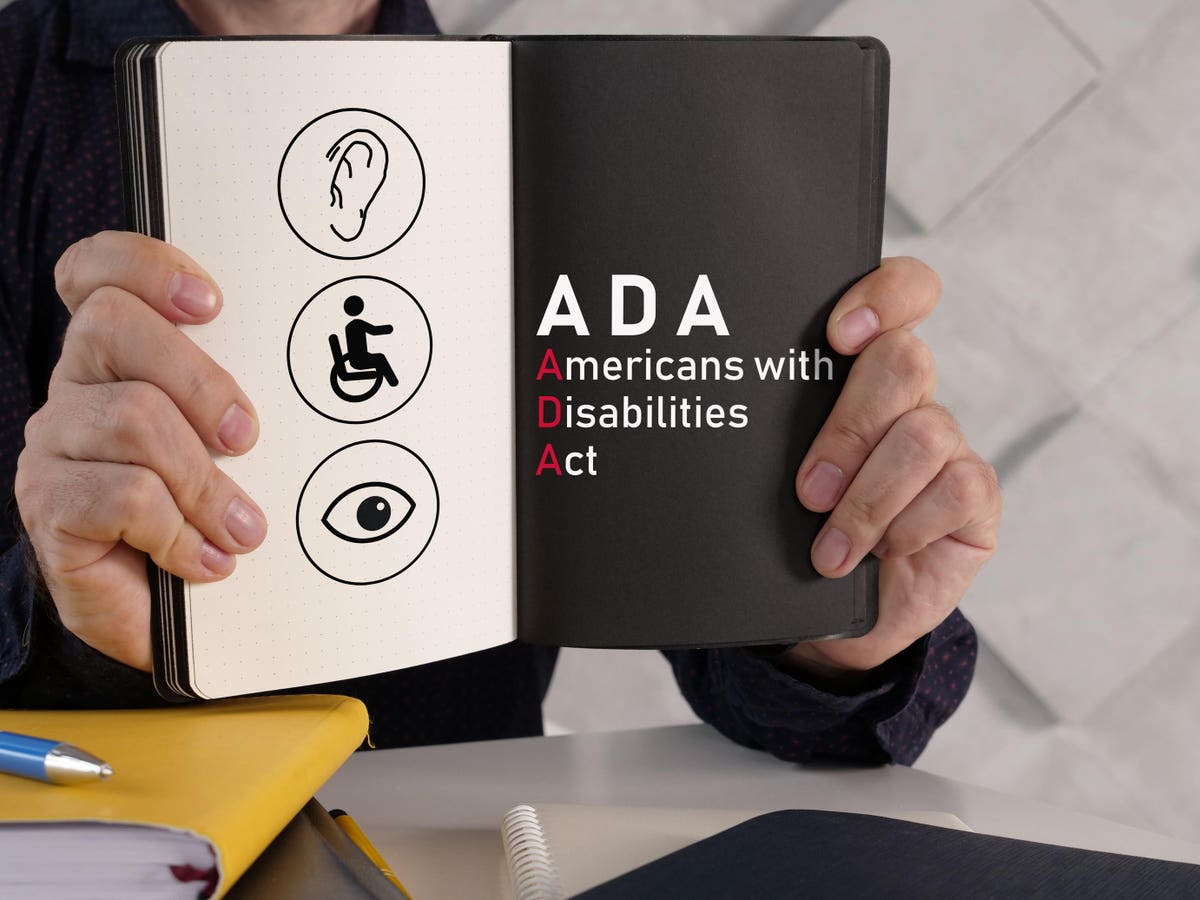Americans with Disabilities Act ADA is shown using a text
getty
The Americans with Disabilities Act (ADA) became law on July 26, 1990. It declared that inclusion was a civil right, not an afterthought.
This past June, at the 35th anniversary of ADA event hosted by Fred Moltz, Chief Accessibility Officer of Verizon, I saw where accessibility is headed. The conversations ranged from the challenges of integrating AI into accessibility programming to the expanding focus on neurodiversity, the lessons of kiosk and user-interface design, and the growing opportunities for people with disabilities in the workforce. Most powerful was the network of leaders convened that day, signaling a shift: accessibility is no longer about compliance. It is about innovation and growth.
The ADA started a movement. The next phase will require rethinking accessibility not as a legal requirement but as a business imperative.
Looking Back: Where We Started
In 1990, accessibility was an unknown. I wore analog hearing aids fitted by an audiologist, but the only accessory available to me was a clunky phone amplifier attachment sold by Radio Shack. These devices were large and conspicuous, and I often felt stigmatized and overlooked. Whether or not it was ever stated outright, I sensed that my visible hearing aids influenced how others perceived my potential and, at times, my opportunities.
Even the language of the time reflected a different mindset. Terms like “handicapped,” “crippled” and “impairment” were commonplace, underscoring how society viewed people with disabilities as broken or limited rather than as individuals deserving of equal access and opportunity.
Digital technology was hardly available to the average consumer. IBM PCs were running MS-DOS with Windows 3.0, and I had just purchased my first Macintosh IIfx, a powerhouse for its day which I used for desktop publishing. It hinted at what technology could offer but remained out of reach for many. There were no streaming devices or mobile integrations, and little thought was given to how people like me could fully participate in a noisy, fast-changing world.
The ADA changed that. It reshaped our built world and provided the legal foundation for inclusion and dignity. But it would take another three decades for businesses to understand that accessibility could be more than compliance, it could be a strategy.
The Progress
The cultural shift since then has been profound. Technology companies have led the charge. Apple has embedded accessibility into its core design language, from VoiceOver to Live Listen, demonstrating how inclusion can be a natural part of product development. Microsoft has elevated accessibility to a corporate priority, appointing a Chief Accessibility Officer and creating tools like Seeing AI and Immersive Reader that improve education and workplace inclusion. Google has launched Live Caption, TalkBack, and Project Relate, expanding access to communication and information.
Retail and service companies are catching up. Starbucks has introduced signing stores and trained baristas in American Sign Language, while Target has improved its physical and digital accessibility standards to serve all customers better. Delta Air Lines has emerged as a leader in accessible travel. Its Advisory Board on Disability, the longest-running airline board, guides decisions across its operations. Delta pioneered an accessible flight map for low-vision travelers on hundreds of aircraft, based on honest user feedback. It is also collaborating with the FAA and DOT to develop in-flight wheelchair seating, allowing travelers to remain in their wheelchairs, a milestone project likely to influence the industry. These efforts have positioned Delta as a model for inclusive travel and customer service.
This is not just corporate goodwill. These companies are proving that inclusive design attracts new customers, strengthens brand loyalty, opens untapped markets, and reduces litigation risk. Accessibility, once seen as an expense, has become an engine for growth and resilience.
Organizations like Disability:IN, The Valuable 500, and M-Enabling are educating leaders to integrate accessibility into their organizations, making it a central part of corporate strategy rather than an afterthought.
Yet even with these advancements, accessibility remains inconsistent. Too many organizations still approach it as compliance rather than innovation. That mindset is a liability and a missed opportunity.
Accessibility as an Economic Driver
Accessibility is also economic, and investors are increasingly recognizing its potential. Samaritan Partners, led by Chris Maher, invests in ventures like the Schoolhouse Hotel, where universal design drives inclusion and commercial returns. Enable Ventures, founded by Regina Kline, has become the first impact fund dedicated exclusively to disability-led innovation, closing the capital gap for overlooked founders. The Disability Opportunity Fund is supporting accessible community development and infrastructure.
Collectively, these efforts are opening the door to a global disability market worth over 13 trillion dollars in annual disposable income, a figure that includes people with disabilities and their friends, families, and caregivers (World Economic Forum). Yet research shows that fewer than 5 percent of Fortune 500 companies report accessibility as a strategic priority, leaving enormous economic and competitive value untapped.
Three Approaches to the Future
To move accessibility beyond compliance and into competitive advantage, three approaches are essential.
Maher represents the investor lens. He argues that sustainable accessibility-driven businesses require the same discipline as any other, a clear value proposition, a path to scale, and leadership delivering impact and returns.
Robert Ludke offers the strategist’s view. A former staffer for Senator Tom Harkin, one of the ADA’s chief architects, he now advocates through his firm, Value Inclusion that inclusion expands markets and strengthens organizations from within.
Frances West exemplifies the leadership approach. As IBM’s first Chief Accessibility Officer and now through her consultancy, FrancesWestCo, she challenges companies to embed inclusion into their culture and operations. She continues to preach what she practiced at IBM: accessibility must be modeled at the top, measured like any other business priority, and used as a catalyst for innovation.
Together, these approaches, capital, strategy, and leadership, define the blueprint for where accessibility must go next.
Building Skills and Networks
Accessibility is not only a matter of technology or policy. It is about careers, independence, and mobility. The CTA Foundation, led by Steve Ewell, supports nonprofit programs and startup pitch competitions and convenes leaders to explore how technology can improve the lives of older adults and people with disabilities. At CES 2025, the Foundation hosted its largest-ever Accessibility Roundtable, showcasing how inclusion can drive creativity, collaboration, and growth.
Companies like Verizon’s Office of Accessibility are turning conversation into action by hosting dialogues on technologies, inclusive design and business models. Organizations like Toyota, Mitsubishi Electric America Foundation, and Amazon demonstrate how industry collaboration with communities can accelerate accessibility across sectors.
Beyond Work: Travel and Leisure
Leaders like Fred Maahs, founder of Journeyable, are reshaping inclusive travel by connecting people with disabilities to verified accessible experiences around the globe. Journeyable empowers travelers to explore confidently while helping the hospitality industry recognize the economic value of inclusive tourism.
Innovators such as Discover Live offer virtual, live‑guided travel experiences that make destinations accessible to individuals who face physical, financial, or logistical barriers. These platforms demonstrate that accessibility is as much about technology and experience design as physical accommodations.
Wheel the World, a U.S.-based travel platform, is taking inclusive tourism further by offering curated, fully accessible trips for people with disabilities, including lodging, transportation, and activities tailored to individual needs. According to the Harris Poll, commissioned by Open Doors Organization, Americans with mobility disabilities spend approximately $58.2 billion annually on leisure travel, taking nearly as many trips as travelers without mobility issues (Bloomberg). This represents a massive and underserved customer base.
These initiatives highlight that accessibility in travel and leisure is more than just regulatory compliance. It is a strategic business opportunity. Organizations that deliver seamless, barrier‑free experiences win customer loyalty and position themselves competitively in a multi‑billion‑dollar market.
What Comes Next
The following 15 years will define whether accessibility becomes embedded in the DNA of business or remains a patchwork of good intentions.
Artificial intelligence holds promise for making accessibility more personalized and scalable. Imagine AI-driven assistants that provide real-time language translation, cognitive support tools for people with neurodiverse needs, or adaptive interfaces that adjust to a user’s unique sensory profile. These possibilities could radically expand participation in work, education, and society.
But there are complicated questions. Will AI replace human interpreters in ways that compromise cultural nuance? Can automated systems maintain users’ privacy and dignity? The rapid adoption of AI makes these questions urgent and demands that accessibility experts have a seat at the table in its design.
Hardware innovations are also reshaping the landscape. Smart glasses like the Ray Ban Meta Smart Glasses reframe how we access visual and auditory information on the go. Companies like Nuance Hearing are advancing assistive listening beyond traditional hearing aids, creating devices that integrate seamlessly into daily life. These are not clunky add-ons. They are sleek, lifestyle-oriented tools that make accessibility feel natural, even aspirational.
Imagine this future by 2035: airports where AI-powered wayfinding guides direct passengers with low vision from curb to gate without human intervention, workplaces where adaptive software reshapes workflows in real time for employees with cognitive differences, and hotels where accessibility is designed so intuitively that no one needs to ask for accommodations. This is not science fiction. It is the logical outcome of combining accessibility with technology, design, and intent.
In short, accessibility is moving from reactive and compliance driven to proactive and user-centered. The companies that get this right will not only meet legal standards, but they will also set cultural ones.
ADA at 50: A Call to Action
By the ADA’s 50th anniversary, we could live in a world where people with disabilities lead in every sector, where travel and technology are designed by default for all, and where accessibility is a cultural expectation, not a compliance exercise.
For me, the journey from a clunky Radio Shack phone amplifier and MS-DOS-based PCs in an era when words like “handicapped,” “crippled,” and “impairment,” defined public discourse to today’s AI-powered tools and integrated design is a reminder of how far we have come. But it also underscores how much work remains.
The ADA began with urgency. Its future depends on imagination. If accessibility is not part of your growth strategy, it is part of your risk profile. The companies that seize this opportunity will define the next decade of innovation. Those who do not will be left behind.









